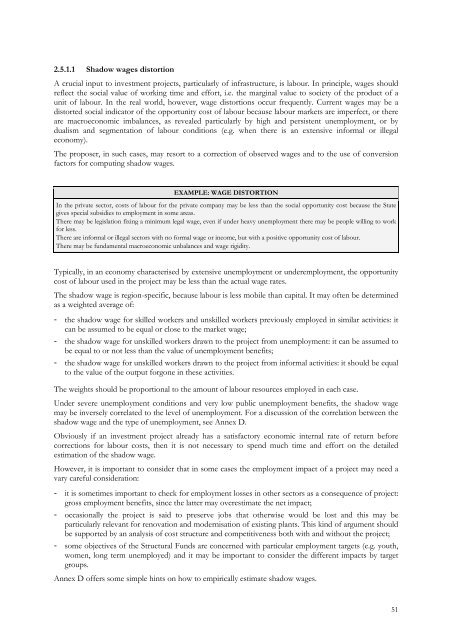Guide to COST-BENEFIT ANALYSIS of investment projects - Ramiri
Guide to COST-BENEFIT ANALYSIS of investment projects - Ramiri
Guide to COST-BENEFIT ANALYSIS of investment projects - Ramiri
Create successful ePaper yourself
Turn your PDF publications into a flip-book with our unique Google optimized e-Paper software.
2.5.1.1 Shadow wages dis<strong>to</strong>rtionA crucial input <strong>to</strong> <strong>investment</strong> <strong>projects</strong>, particularly <strong>of</strong> infrastructure, is labour. In principle, wages shouldreflect the social value <strong>of</strong> working time and effort, i.e. the marginal value <strong>to</strong> society <strong>of</strong> the product <strong>of</strong> aunit <strong>of</strong> labour. In the real world, however, wage dis<strong>to</strong>rtions occur frequently. Current wages may be adis<strong>to</strong>rted social indica<strong>to</strong>r <strong>of</strong> the opportunity cost <strong>of</strong> labour because labour markets are imperfect, or thereare macroeconomic imbalances, as revealed particularly by high and persistent unemployment, or bydualism and segmentation <strong>of</strong> labour conditions (e.g. when there is an extensive informal or illegaleconomy).The proposer, in such cases, may resort <strong>to</strong> a correction <strong>of</strong> observed wages and <strong>to</strong> the use <strong>of</strong> conversionfac<strong>to</strong>rs for computing shadow wages.EXAMPLE: WAGE DISTORTIONIn the private sec<strong>to</strong>r, costs <strong>of</strong> labour for the private company may be less than the social opportunity cost because the Stategives special subsidies <strong>to</strong> employment in some areas.There may be legislation fixing a minimum legal wage, even if under heavy unemployment there may be people willing <strong>to</strong> workfor less.There are informal or illegal sec<strong>to</strong>rs with no formal wage or income, but with a positive opportunity cost <strong>of</strong> labour.There may be fundamental macroeconomic unbalances and wage rigidity.Typically, in an economy characterised by extensive unemployment or underemployment, the opportunitycost <strong>of</strong> labour used in the project may be less than the actual wage rates.The shadow wage is region-specific, because labour is less mobile than capital. It may <strong>of</strong>ten be determinedas a weighted average <strong>of</strong>:- the shadow wage for skilled workers and unskilled workers previously employed in similar activities: itcan be assumed <strong>to</strong> be equal or close <strong>to</strong> the market wage;- the shadow wage for unskilled workers drawn <strong>to</strong> the project from unemployment: it can be assumed <strong>to</strong>be equal <strong>to</strong> or not less than the value <strong>of</strong> unemployment benefits;- the shadow wage for unskilled workers drawn <strong>to</strong> the project from informal activities: it should be equal<strong>to</strong> the value <strong>of</strong> the output forgone in these activities.The weights should be proportional <strong>to</strong> the amount <strong>of</strong> labour resources employed in each case.Under severe unemployment conditions and very low public unemployment benefits, the shadow wagemay be inversely correlated <strong>to</strong> the level <strong>of</strong> unemployment. For a discussion <strong>of</strong> the correlation between theshadow wage and the type <strong>of</strong> unemployment, see Annex D.Obviously if an <strong>investment</strong> project already has a satisfac<strong>to</strong>ry economic internal rate <strong>of</strong> return beforecorrections for labour costs, then it is not necessary <strong>to</strong> spend much time and effort on the detailedestimation <strong>of</strong> the shadow wage.However, it is important <strong>to</strong> consider that in some cases the employment impact <strong>of</strong> a project may need avary careful consideration:- it is sometimes important <strong>to</strong> check for employment losses in other sec<strong>to</strong>rs as a consequence <strong>of</strong> project:gross employment benefits, since the latter may overestimate the net impact;- occasionally the project is said <strong>to</strong> preserve jobs that otherwise would be lost and this may beparticularly relevant for renovation and modernisation <strong>of</strong> existing plants. This kind <strong>of</strong> argument shouldbe supported by an analysis <strong>of</strong> cost structure and competitiveness both with and without the project;- some objectives <strong>of</strong> the Structural Funds are concerned with particular employment targets (e.g. youth,women, long term unemployed) and it may be important <strong>to</strong> consider the different impacts by targetgroups.Annex D <strong>of</strong>fers some simple hints on how <strong>to</strong> empirically estimate shadow wages.51




